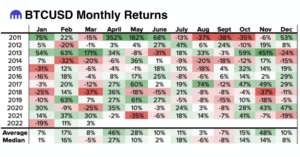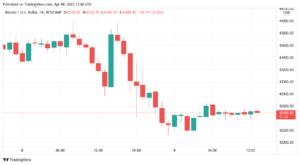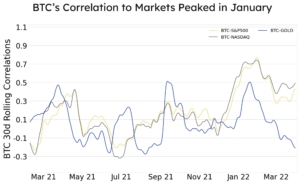BTC analysts are keeping a very close eye on the cryptocurrency this month and for very good reason: bitcoin has predictably performed very well in November and April.
In fact, BTC has experienced an average gain of 46% (and a median gain of 27%) every year in the month of April since 2011.
 Critics of BTC have been warning for the past month that the coin is at risk of falling and staying below $40k per share. Data from Cointelegraph markets seems to signal some concerns late last week with a 10% weekly red candle, signaling some weaker support for the cryptocurrency recently.
Critics of BTC have been warning for the past month that the coin is at risk of falling and staying below $40k per share. Data from Cointelegraph markets seems to signal some concerns late last week with a 10% weekly red candle, signaling some weaker support for the cryptocurrency recently.
 Other critics still seem to still be fixated on BTC’s correlation to the markets, but that narrative seems to have sailed. Check out the correlative split earlier this year. It’s too early to tell if this split from the markets is temporary or an early signal of a more permanent course correction. If the last 3 months of a rolling correlation – or lack thereof – are any indication of a new trend, we may have one:
Other critics still seem to still be fixated on BTC’s correlation to the markets, but that narrative seems to have sailed. Check out the correlative split earlier this year. It’s too early to tell if this split from the markets is temporary or an early signal of a more permanent course correction. If the last 3 months of a rolling correlation – or lack thereof – are any indication of a new trend, we may have one:

Whales seem to disagree with the narratives that BTC is ailing, not able to rebound, and are too tied to the markets, however. In fact, whales seem to be hoping history repeats itself this month with a major bull run in April. To some, $200m in liquidation early in the weekend caused concern about BTC’s prospect for a strong rebound this month. To crypto whale investors, though, it proved to be a feeding frenzy for whales who were buying up new supplies from sellers as they exited.
What’s behind the predictable volatility of BTC?
Much of BTC’s volatility is by design. Without a governing body like a central bank to control its limited supply, the value placed on its scarcity is higher than that of its competitors. Presently, there are already over 19 million bitcoins in circulation, and that number increases when new blocks are mined approximately every 10 minutes. That means that less than 2 million BTC are available for purchase before the cryptocurrency reaches its maximum supply of 21 million.
Spot selling can cause dramatic shifts in the stock and crypto markets and since the digital currency is still so new, it has a limited trading history. In fact, it’s still within what analysts call a “price discovery phase” which is among the most volatile phases of any asset’s lifecycle. In short, this means that the asset is still too new for the price to be determined yet. Over time, as buyers and sellers interact and trade the asset, the tangible and intangible factors that use to determine pricing will continue to shape the value of newer currencies like Bitcoin.
That’s one of the reasons why maximalists say the long game is so critical for prominent assets like bitcoin.
So grab the tums and a tall glass of water for this bumpy ride, because it seems like we are nowhere near landing on an agreement about BTC’s future.
About the Author

Michael Hearne
About Decentral Publishing
Decentral Publishing is dedicated to producing content through our blog, eBooks, and docu-series to help our readers deepen their knowledge of cryptocurrency and related topics. Do you have a fresh perspective or any other topics worth discussing? Keep the conversation going with us online at: Facebook, Twitter, Instagram, and LinkedIn.


